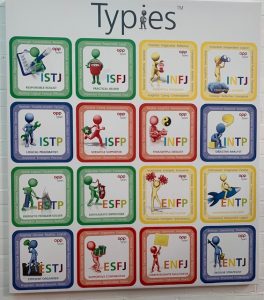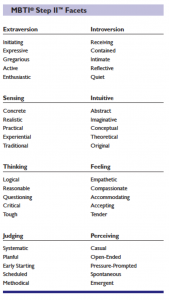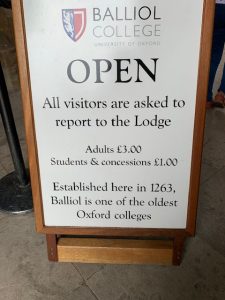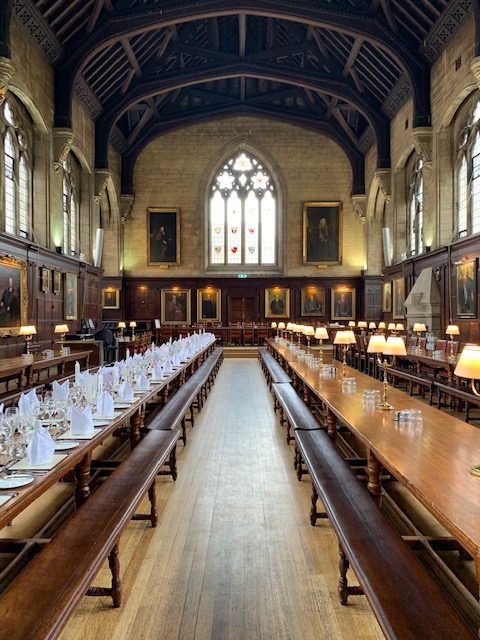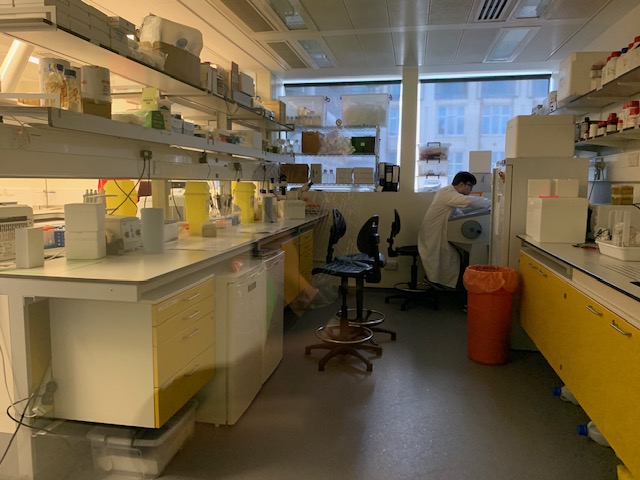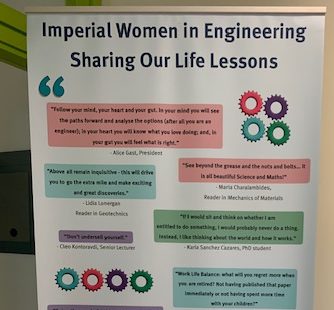TUESDAY, June 18 2019 – The Myers Briggs Company
 I was thrilled to visit the global office of the Myers Briggs Company, located in Oxford.
I was thrilled to visit the global office of the Myers Briggs Company, located in Oxford.
A bit of background… For many years, I have been extremely engaged with the personality and interest assessments of The Myers Briggs Company, learning as much as possible about these tools and administering them to my clients. These assessments include the Myers Briggs Type Indicator (MBTI), based on Jungian psychology and used to determine innate personality; and the Strong Interest Inventory, which identifies interests in academics, activities, and career paths.
I have administered and interpreted these assessments with hundreds of individuals from 14 years of age through 50, and have conducted workshops with organizations on how to use the MBTI assessment to strengthen teamwork, communication, and collaboration at their company.
I regularly meet with the marketing and product directors of the Myers Briggs Company in the United States. On Tuesday, I had the great opportunity to meet with Liane Hawthorne, the Director of Marketing for the global division of the Myers Briggs Company.
As you may know, the MBTI looks at four dimensions of personality, with each having two preference options:
Each individual’s preferences for these four dimensions produces a 4-letter personality “type.” For example, my type is ENFJ, including a preference for Extraversion, Intuition, Feeling, and Judging. Identifying an individual’s 4-letter personality type is considered Step I.
There are 16 potential personality types. Each type has its own strengths and potential blind spots; as well as preferences for learning, communication, teamwork, and managing conflict and stress.
The front of the Myers Briggs Company headquarters displays the diagram below, summarizing a few salient features of each of the 16 types:
Liane presented a fascinating metaphor, that we can each imagine that we live in an enormous 16-room home. We have our favorite room (which corresponds to our particular personality type), but we need to go into the different rooms to perform different activities. For example, a research activity might require an ISTJ approach. It’s beneficial to learn how to function in the different rooms, but we always want to come back to our “home-room,” where we feel most comfortable, to recharge.
It’s possible to take a more advanced examination of an individual’s personality type, in which we look at “facets” within each personality preference to further differentiate the person; this requires a Step II analysis.
Here are the five facets within each of the eight preferences:
I always administer the Step II MBTI because these facets can reveal so much about a person, and can help individualize his or her personality. For example, I am an ENFJ, with “out-of-preference” Thinking facets of Logical and Questioning. For my other preferences of Extraversion, Intuition, and Judging, all my facets are within preference. My resulting personality type is: Logical, Questioning, ENFJ
It was very gratifying to feel part of the MBTI community! At the Myers Briggs Company’s global headquarters, I felt surrounded by people dedicated to helping others increase their self-awareness and personal effectiveness!
TUESDAY June 18, 2019 – Balliol College, Oxford University
As you may recall from my previous blogs, the University of Oxford is comprised of about 30 individual colleges, each run as a separate, distinct entity and each with its own culture.
 Prospective students apply to a particular academic “faculty,” or degree program, within a specific college. Each college chooses which academic fields to offer based on the faculty members, or tutors, affiliated with the college. Not all academic fields are offered by all colleges. For example, the very popular PPE program (Philosophy, Politics, and Economics) is offered by 32 colleges; more Prime Ministers have a PPE degree than any other. In contrast, Earth Sciences is only offered by six of the Oxford colleges, and History of Art by eight.
Prospective students apply to a particular academic “faculty,” or degree program, within a specific college. Each college chooses which academic fields to offer based on the faculty members, or tutors, affiliated with the college. Not all academic fields are offered by all colleges. For example, the very popular PPE program (Philosophy, Politics, and Economics) is offered by 32 colleges; more Prime Ministers have a PPE degree than any other. In contrast, Earth Sciences is only offered by six of the Oxford colleges, and History of Art by eight.
Students’ academics are a combination of lectures offered by their department to all students pursuing a degree in their “faculty,” and tutorials offered by their college by the faculty affiliated with their college. For the first year, students participate mostly in tutorials in their own college; and in years 2 and 3, may take courses in other colleges.
This blog will focus on Balliol College, “arguably the oldest college in Oxford, founded in 1263. It has stood on a single site longer than any other college in the English-speaking world,” according to the current Master, Dame Helen Ghosh.
When I visited, I chatted with three students. One student was from a small town in northern England, and was studying Maths (the British term for Mathematics), and did his thesis work in theoretical number theory (such as imaginary numbers). After graduation, he was going to pursue a PhD. from the University of Durham, where I visited several years ago. Two other students were friends from Germany. One was studying PPE; he visited Balliol and chose it based on its central location and the warmth of the student body. The other was studying history; he never visited but learned about Balliol from virtual tours.
With about 400 undergrads and 400 grad students, Balliol is a relatively medium-sized college within Oxford. It consists of several beautiful quads, including Front Quad below, bordered by two libraries and the chapel.
The Old Library was built in the 15th century, originally for Fellows’ use only.
The “New” Library was also built in the 15th century, originally as a dining hall, and converted to the humanities part of the library in 1877. Both libraries are very popular for residents of Balliol, but they are free to use other libraries around campus as well.
Below is a photo of the Chapel, which is the third one on the site.
Students and faculty eat in the Hall, reminiscent of Harry Potter’s school facilities! Surrounding the tables are portraits of Masters and alumni. Balliol alums have included nine Nobel Prize winners and three Primer Ministers.
At the far end of Hall is the Faculty table, where the faculty dine every meal. The elevation of the faculty table is intended to convey the higher stature of the faculty and the respect they deserve.
Master Ghosh described why she chose to join Balliol: “The reputation that Balliol has – of academic excellence, a sense of social responsibility, and intellectual independence – perhaps especially suited me most of all.”
Monday, June 17th – Bioengineering at Imperial College
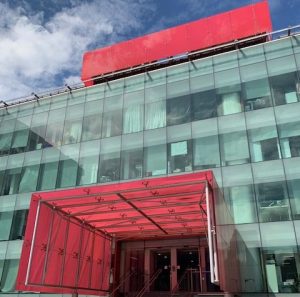 WHY STUDY BIOENGINEERING AT IMPERIAL?
WHY STUDY BIOENGINEERING AT IMPERIAL?
Since Imperial is devoted to the study of STEM, and bioengineering is an interdisciplinary STEM field, the combination of bioengineering and Imperial is powerful!
While many undergraduate fields of study at Imperial (and in fact throughout England) are 3-year programs, the Bioengineering degree is available only as a 4-year MEng degree or 5-year MEng degree, including a Year in Industry. As such, you graduate with much stronger credentials.
Imperial’s bioengineering program houses state-of-the-art facilities. The first two years include required core courses, with a deep coverage of the life sciences.
The bioengineering program includes a significant research component. In the third year, students work on a group project to solve real-world problems. As described by Lorna Stevenson, the Admissions and Outreach Manager for Bioengineering, “engineering is a team sport!” In fact, the interview plays a large role and students are encouraged to interview in person on the Imperial campus; in addition to an individual interview, applicants are given a group task to see how well they deal with solving engineering problems within a group. The photo below shows a backstroke device developed by a bioengineering team for Andrew Mullen, a Paralympian swimmer.
In the fourth year, students conduct an individual research project and take electives in their specialized field of interest. The seven fields of research illustrate the interdisciplinary nature of the program:
- Biomechanics and Mechanobiology
- Biomedical Sensing, Diagnostics, and Imaging
- Computational and Theoretical Modeling
- Medical Devices
- Molecular and Cellular Bioengineering
- Regenerative Medicine and Biomaterials
- Neurotechnology and Robotics
A tour through the Bioengineering labs illustrates the exciting scope of research projects designed to improve the lives of human beings.
Finally, Imperial College is committed to supporting women in STEM, and participates in the UK Athena Swan program. 54% of students in the bioengineering program are women, and Imperial received a silver Athena award this year in recognition of its support of women in its student and faculty population.
Stay tuned for more updates from my trip, including information on Oxford University, Kings College, University College London, and the Myers Briggs Company.
Monday June 17th – Imperial College
I was very excited to re-visit Imperial College, one of the top STEM universities in the world! Imperial can credit its existence to the vision of Prince Albert, a big believer in the power of STEM; he helped establish the Royal College of Chemistry in 1845, the earliest school of Imperial. Over the years, the university has grown steadily and incorporated other educational institutions, and at present includes three streams of study: Medicine, Engineering, and Natural Sciences.
Imperial’s main campus is in South Kensington. As part of its continual expansion, it recently opened the Francis Frick Institute, a partnership with Kings College, University College London, and several governmental science institutes, to form the largest biomedical research center in Europe.
MEDICINE DEGREE AT IMPERIAL: OVERVIEW
Unlike in the US, medicine can be studied on the undergraduate level at UK universities. As such, learning about the UK Bachelors degree in medicine provides an interesting glimpse into an alternative approach to medical education. In America, medical education on the graduate level is required, preceded by pre-medical education in the undergraduate year in the form of 8 required science and math courses.
Typically undergraduate education in England consists of a 3-year Bachelor’s program, but Medicine at Imperial totals 6 years; this includes a 4-year course of study for the BSc degree (Bachelors of Science) followed by a 2-year program for the MBBS degree (Bachelor of Medicine and Bachelor of Surgery) with a complete cycle through all medical and surgical specialties.
A unique feature of studying medicine at Imperial is that the program is steeped in basic science and research-based, so you are fully qualified to become a scientific researcher and/or clinician when you graduate. In addition, the hospitals affiliated with Imperial serve a wide variety of patient populations, from St. Mary’s, where the royal babies are born, to the the Surrey Hospital, which serves rural populations.
MEDICINE CURRICULUM AT IMPERIAL
The medicine curriculum at Imperial has recently undergone a complete review, and a new curriculum will be implemented shortly, consisting of 3 “phases” of study:
Phase 1 (Years 1-3)
The first 3 years of study will be non-clinical science based, but students will be exposed to relevant clinic work; for example, when studying the cardiology system, students will observe a cardiology ward. In the 3rd year, students will have longer clinical “attachments” (rotations) in various hospitals and clinics, during which they will take histories, go into wards, and shadow doctors. They will be exposed to a variety of environments, including primary care in communities, in-hospital clinics, and out-patient clinics.
Phase 2 (Year 4)
In the 4th year, students complete a research project to obtain the BSc degree. There are 11 different pathways from which to choose. Management and bioengineering are among the more popular pathways. New options this year include surgical innovations and cancer frontiers. For example, a student team in bioengineering developed a rowing sleeve for Pam Relph, diagnosed with Psoriatic Arthritis at a young age, in order to assist her training on the ergometer; this enabled her to achieve her dream to become a World Rowing Champion.
Phase 3 (Years 5-6)
Years 5 and 6 are the senior clinical years, and include “preparing for practice” longer rotations. During this period, students can pursue clinical attachments in elective areas in which they wish to specialize during their careers. At each point of the attachments, students are required to do practical assessments such as medical procedures or reflective pieces.
After graduation, students do two Foundation years, in which they practice medicine, and are paid; in the second Foundation year, they can begin to specialize.
INTERVIEWS
Imperial is moving from the traditional structured interview to the MMI (Multiple Mini-Interview). There will be seven stations; at each station, students receive a question, have 2 minutes to prepare, and 5 minutes to speak with an interviewer in response to the prompt. The stations will cover the following topics. A current medical school would lead the last station:
- Work experience – 2 stations
- Teamwork and leadership
- Empathy and ethics
- Value-based scenarios – 2 stations
- Contribution to Imperial Medical School community
PARTICIPATION OF US STUDENTS
Increasing numbers of US students are applying and attending medical school at Imperial, due to the ability to study medicine on the undergraduate level. US applicants can subsequently practice medicine if they pass the Step 1 and Step 2 USMLE medical boards (US Medical Licensing Examination). While it’s possible to return to the US after the 1st Foundation year, it’s recommended to complete both Foundation years in order to have the flexibility to practice medicine in the UK in the future.
UP NEXT…
Stay tuned for future blogs about Imperial’s Bioengineering degree, Oxford University, Kings College London, University College London, the Royal Central School of Drama, and the Myers Briggs Company! For more information on applying to the Medicine program at UK universities, see our previous blog.
Saturday, June 15th – Departure!
Starting today, I’m off on my fourth trip to the UK to visit universities—and I’ll be sharing my knowledge and insights here, in this blog, from start to finish.
On this trip, I will return to top universities including Oxford, Imperial, King’s, and University College London. But this time, I’ll be focusing on unusual degree programs unavailable in US undergraduate institutions like medicine and law. While in Oxford, I will also meet with global directors of The Myers Briggs Company, to discuss worldwide applications of personality and interest assessments. I’ll then continue on to visit a variety of unique and prestigious schools, including the Royal Central School of Drama.
Finally, I’ll also be traveling to the Netherlands to visit the University of Amsterdam for the first time.
Stay tuned for daily updates, and check out our previous UK live blog, as well as our blog on how to apply to UK universities.



